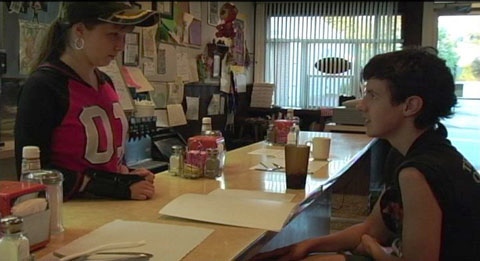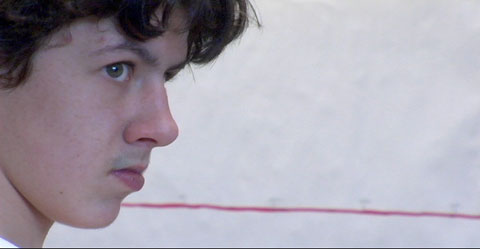Billy the Kid: “Can you see inside me?”
By Joanne Laurier
31 March 2009
Directed by Jennifer Venditti
American filmmaking, by and large, including its "independent" cinema, is not attuned either thematically or artistically to the most important problems in life. And the two deficiencies are interrelated. A determined interest in life, including the lives and realities of the vast majority of the population, leads to the discovery of complex problems, problems that demand sensitive and poetic treatment. Vulgarity and simplification will not get artists anywhere.
Billy the Kid, a documentary directed by Jennifer Venditti (See accompanying interview An interview with Jennifer Venditti, director of Billy the Kid), is an unusual film. It focuses on Billy P., a 15-year-old with Asperger syndrome living in Lisbon Falls, Maine. The movie treats Billy's difficult situation, but it also provides other, rare glimpses of American life. The movie has won awards at film festivals in Los Angeles, Melbourne and Edinburgh.
 Billy the Kid
Billy the KidBilly, described by the director as something of "a young Don Quixote," explains to the camera: "I'm at war with myself...fighting my emotions." As a child, he was given to terrible temper tantrums; he is now estranged from his classmates. His condition, which makes social interaction problematic and lends his behavior an eccentric quality, has made him something of an outcast. But he possesses a fascinating, eclectic wisdom and he makes the case that in life's hardships—and his life is a hard one—one can "find great things."
From the film's outset, Billy opens himself up emotionally. His observations are keen. "Can you see inside me?" he asks at the movie's start. The question proves to be a revealing invitation. He is self-aware, his discussions with his mother, Penny, are intimate. The teenager has the ability to be acutely present in the moment, making him a sort of sensitive communication device through which human drama is transmitted.

This enables Billy the Kid to be more than simply his story—it becomes the story to a certain extent of a town and its people. The small working class community is where Billy lives and sparks intricate relationships. While the teenager is the film's focus, an assortment of personalities enters the picture in an atypical way.
Venditti explains how Billy came to be the heart of a documentary in the film's production notes: "In making the film, I wanted to pass along to an audience the feeling I had when I was with Billy, while many adults were amazed and patient with him, a majority were suspicious, alarmed and cautious. My urge to figure out what was wrong with him was quickly replaced by uncomplicated appreciation and empathy....
"You might say we began filming as outsiders and ended as insiders. We saw his mother Penny being his only real friend but someone too close to his emotional gravity. While I conducted several interviews with teachers, students, family members and specialists, I ultimately threw them out in favor of Billy's voice. He tells the story himself, by being himself. All we have to do is experience Billy while he responds to a painful and riveting childhood, first time love, and life as an outcast."
Billy moves through life with few inhibitions. Unfazed by the camera, Billy allows Venditti, who filmed for eight days during the summer and winter of 2005, to record his joys and pains. At one point, he speaks rather objectively of a childhood with an abusive, drug-addicted father who long ago abandoned the family ("Always be careful about how you treat a child—be careful never to abuse them"). "Truckstops of America" emblazoned on Billy's T-shirt is a reminder that as a child he rode in his father's truck and was his "bud." This is obviously a tough contradiction for one so young to absorb and handle.
Wandering or sitting in the spacious yard around his mobile home, Billy has frequent talks with his mother. They both agree life is better with Billy's stepfather, a disc jockey at a local radio station who never appears on camera and whose profession gives Billy certain bragging rights.
Then Heather, whose family owns a diner on the main street, enters the scene via her protective younger brother. She becomes Billy's "first and only girl-friend." It is more comfortable for Billy, who describes his condition to the girl's family as "bronchitis," to begin a friendship with someone who also "has issues"—Heather is partially blind. ("I feel like I've mistaken her for an angel. The way I feel for her is like fire, it's not a little flame, but a towering inferno!") Responding to cheers from a group of townspeople over their relationship, the 15-year-old laments all too earnestly, "these years of loneliness have been murder."
"A weird dance between an old soul and a naïve boy," says Venditti of Billy in an interview on the film's DVD. He is someone not hampered, at this point, by social "guiders." By this, the filmmaker means, as she told HBO, that perhaps the "qualities that Billy possesses are these innate qualities that all of us come into the world with. And than we learn over time how to build up defenses and get callous to those things because you need to survive in the world." The director contends that this state of affairs provides a rare perspective.
Billy—("It's hard to let go of things in your mind")—tries to remember that "imagination ain't real," even though an imaginary world "is better than the real world." But as Billy the Kid makes clear, the protagonist's rich imagination and internal life are nourished by more than pop culture. Billy reads voraciously and is knowledgeable about many things. His language is precocious and often poetic. On one occasion, he and his mother talk casually about French impressionist painters. Nightfall in Lisbon Falls' deserted downtown lyrically reminds him of "the moors."
There are many moving episodes in the film. In one scene, after a heartbreak, he asks his mother whether the expression "love hurts" comes from the uncontrolled pounding of the heart. His recovery from the pain entails walking in the woods quoting from the Robert Frost poem, "Nothing (Gold) Can Stay." He concludes that the poet is saying, "beware of changes." "If you care for someone so much, make them happy, give them the freedom they want," he adds in a comment wise beyond his years.
Venditti says that Billy has "gleaned so much information from movies and books and social situations that these people have been his resource. He imagines, what would Cary Grant do in this situation? Because he doesn't know how to do it the way we do it, but he knows that in order to survive in this world he's got to know how to do it, so if he's going to learn from anyone he wants to learn from these people."
If one were to raise criticisms of the film it would be along these lines: Venditti is sensitive to, and, in fact, has made a career out of discovering "exceptional individuals." This is a strength, but it can become a little one-sided. In the film, there is perhaps too much emphasis on Billy's "specialness" at the expense of broader questions. There is always the danger that viewers and critics will choose to see this as the portrait of a particular, "quirky" personality rather than seeing that through this adolescent's wide-open eyes we are privileged to see quite typical elements of life.
Billy may be something of an outcast, but, in a sense, the entire population on display in the film is an "outcast" in the eyes of the American media, entertainment industry and political establishment. Why are such people's lives excluded as a rule, why is there so little artistic interest in the drama of everyday life? The filmmaker is very humane, but these are issues that need addressing.
In any case, she takes life and art seriously. In the course of the DVD interview, Venditti quotes from Albert Maysles, the renowned documentary filmmaker, about reality being "endowed with the power of truth and the romance of discovery." Truly, there is more genuine drama in certain moments of Billy the Kid than in the bombast of many entire films currently in movie theaters.
The approaches of both the youth and filmmaker bring to mind the remarkable essay by literary critic Aleksandr Voronsky, "The Art of Seeing the World." Voronsky argues that it is vital for the artist to see the world "in all its freshness and immediacy.... We are closest to being able to see it in this way in childhood, youth, and in the unusual or rare moments of our lives." Voronsky observes that everyday concerns tend to weigh on us and "render imperceptible what is dearest and most beautiful in life and in the cosmos.... How often it is that we fail to notice or heed the inherently beautiful things and people who are capable of providing us with enchantment, of introducing us to the healing waters of the great universe."
The DVD is available at http://www.billythekiddocumentary.com/





Follow the WSWS